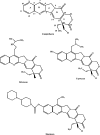Biotechnological approaches for the production of camptothecin
- PMID: 38896329
- PMCID: PMC11186875
- DOI: 10.1007/s00253-024-13187-2
Biotechnological approaches for the production of camptothecin
Abstract
Camptothecin (CPT), an indole alkaloid popular for its anticancer property, is considered the third most promising drug after taxol and famous alkaloids from Vinca for the treatment of cancer in humans. Camptothecin was first identified in Camptotheca acuminata followed by several other plant species and endophytic fungi. Increased harvesting driven by rising global demand is depleting the availability of elite plant genotypes, such as Camptotheca acuminata and Nothapodytes nimmoniana, crucial for producing alkaloids used in treating diseases like cancer. Conservation of these genotypes for the future is imperative. Therefore, research on different plant tissue culture techniques such as cell suspension culture, hairy roots, adventitious root culture, elicitation strategies, and endophytic fungi has been adopted for the production of CPT to meet the increasing demand without affecting the source plant's existence. Currently, another strategy to increase camptothecin yield by genetic manipulation is underway. The present review discusses the plants and endophytes that are employed for camptothecin production and throws light on the plant tissue culture techniques for the regeneration of plants, callus culture, and selection of cell lines for the highest camptothecin production. The review further explains the simple, accurate, and cost-effective extraction and quantification methods. There is enormous potential for the sustainable production of CPT which could be met by culturing of suitable endophytes or plant cell or organ culture in a bioreactor scale production. Also, different gene editing tools provide opportunities for engineering the biosynthetic pathway of CPT, and the overall CPT production can be improved . KEY POINTS: • Camptothecin is a naturally occurring alkaloid with potent anticancer properties, primarily known for its ability to inhibit DNA topoisomerase I. • Plants and endophytes offer a potential approach for camptothecin production. • Biotechnology approaches like plant tissue culture techniques enhanced camptothecin production.
Keywords: In vitro production; Nothapodytes Nimmoniana; Camptotheca acuminata; Camptothecin; Extraction; Quantification.
© 2024. The Author(s).
Conflict of interest statement
The authors declare no competing interests.
Figures




Similar articles
-
Biotechnology of camptothecin production in Nothapodytes nimmoniana, Ophiorrhiza sp. and Camptotheca acuminata.Appl Microbiol Biotechnol. 2021 Dec;105(24):9089-9102. doi: 10.1007/s00253-021-11700-5. Epub 2021 Dec 1. Appl Microbiol Biotechnol. 2021. PMID: 34850279 Review.
-
Biotechnology for micropropagation and camptothecin production in Ophiorrhiza sp.Appl Microbiol Biotechnol. 2022 Jun;106(11):3851-3877. doi: 10.1007/s00253-022-11941-y. Epub 2022 May 21. Appl Microbiol Biotechnol. 2022. PMID: 35596786 Review.
-
Metabolic and transcriptional analyses in response to potent inhibitors establish MEP pathway as major route for camptothecin biosynthesis in Nothapodytes nimmoniana (Graham) Mabb.BMC Plant Biol. 2019 Jul 10;19(1):301. doi: 10.1186/s12870-019-1912-x. BMC Plant Biol. 2019. PMID: 31291885 Free PMC article.
-
Isolation and characterization of Paenibacillus polymyxa LY214, a camptothecin-producing endophytic bacterium from Camptotheca acuminata.J Ind Microbiol Biotechnol. 2015 Aug;42(8):1197-202. doi: 10.1007/s10295-015-1643-4. Epub 2015 Jun 28. J Ind Microbiol Biotechnol. 2015. PMID: 26124076
-
Camptothecin-producing endophytic fungus Trichoderma atroviride LY357: isolation, identification, and fermentation conditions optimization for camptothecin production.Appl Microbiol Biotechnol. 2013 Nov;97(21):9365-75. doi: 10.1007/s00253-013-5163-8. Epub 2013 Aug 15. Appl Microbiol Biotechnol. 2013. PMID: 23949997
Cited by
-
Revisiting Traditional Medicinal Plants: Integrating Multiomics, In Vitro Culture, and Elicitation to Unlock Bioactive Potential.Plants (Basel). 2025 Jul 2;14(13):2029. doi: 10.3390/plants14132029. Plants (Basel). 2025. PMID: 40648038 Free PMC article. Review.
-
The Untapped Potential of Hairy Root Cultures and Their Multiple Applications.Int J Mol Sci. 2024 Nov 26;25(23):12682. doi: 10.3390/ijms252312682. Int J Mol Sci. 2024. PMID: 39684394 Free PMC article. Review.
References
-
- Ahn SK, Choi NS, Jeong BS, Kim KK, Journ DJ, Kim JK, Lee SJ, Kim JW, Hong C II, Jew S-S (2000) Practical synthesis of (S)-7-(2-isopropylamino)ethylcamptothecin hydrochloride, potent topoisomerase I inhibitor. J Heterocycl Chem 37:1141–1144
-
- Ambujakshi NP, Ravikiran T, Raveesha HR (2022) Influence of elicitors on the enhancement of camptothecin accumulation and antioxidant potential in callus cultures of Chonemorpha fragrans. S Afr J Bot 150:225–232
-
- Amna T, Puri SC, Verma V, Sharma JP, Khajuria RK, Musarrat J, Spiteller M, Qazi GN (2006) Bioreactor studies on the endophytic fungus Entrophospora infrequens for the production of an anticancer alkaloid camptothecin. Can J Microbiol 52:189–196 - PubMed
-
- Arbain D, Putra DP, Sargent MV (1993) The alkaloids of Ophiorrhiza filistipula. Aust J Chem 46:977–985
Publication types
MeSH terms
Substances
Grants and funding
LinkOut - more resources
Full Text Sources
Research Materials
Miscellaneous

